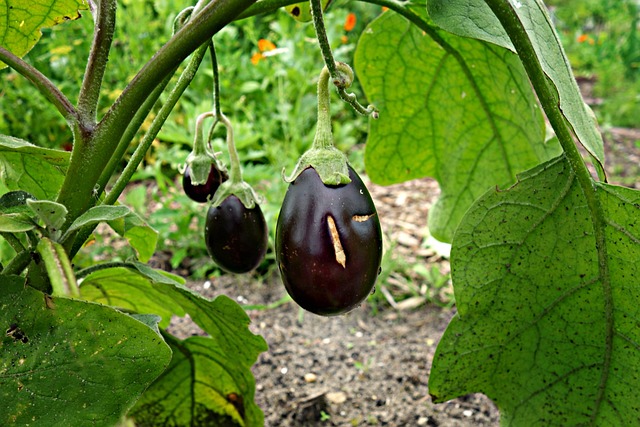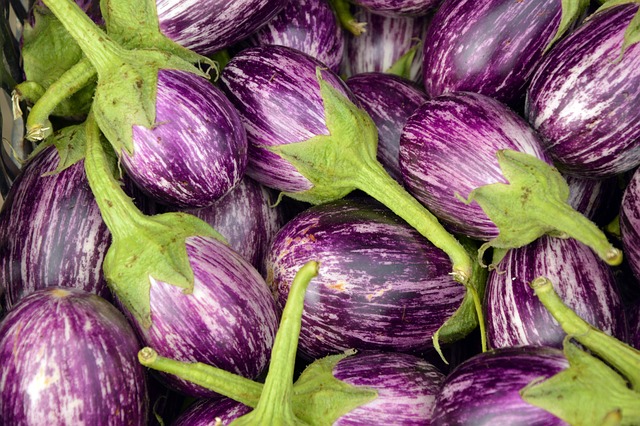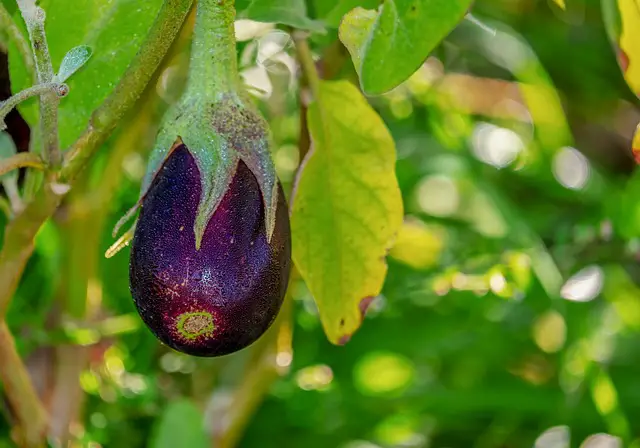Eggplants are a popular vegetable to grow in gardens and farms, but sometimes their leaves can turn yellow, causing concern for growers. Yellowing leaves in eggplants can indicate a variety of issues, ranging from environmental factors to nutrient deficiencies to pests and diseases.
Understanding the causes of Eggplant Leaves Turning Yellow is crucial to effectively treating the issue and ensuring a healthy harvest.
One of the most common causes of yellowing leaves in eggplants is inconsistent watering. Overwatering or underwatering can both lead to yellowing leaves, as can exposure to cold temperatures. Nutrient deficiencies and soil conditions can also cause yellowing leaves, as can diseases and pests affecting eggplants.
Environmental factors, such as excessive heat or light, can also contribute to the problem. By recognizing the symptoms of yellowing leaves and understanding the possible causes, growers can take steps to prevent and treat the issue.
Key Takeaways
- Yellowing leaves in eggplants can indicate a variety of issues, including inconsistent watering, nutrient deficiencies, diseases, pests, and environmental factors.
- Understanding the causes of yellowing leaves is crucial to effectively treating the issue and ensuring a healthy harvest.
- Preventing yellowing leaves in eggplants involves proper care and maintenance, including regular watering, soil testing, pest control, and monitoring environmental conditions.
More posts on this category:
- Why Are My Cyclamen Leaves Turning Yellow?
- Why Are My Cantaloupe Leaves Turning Yellow?
- Why Are My Calathea Leaves Turning Yellow?
Understanding Eggplant and Its Needs

Eggplants, also known as aubergines, belong to the nightshade family of vegetables. They are native to India and are now widely grown in many parts of the world. Eggplants are warm-season plants that require plenty of sunlight, warmth, and well-draining soil to grow properly.
As a member of the nightshade family, eggplants are related to other plants such as tomatoes, peppers, and potatoes. Like these plants, eggplants are susceptible to certain pests and diseases that can affect their growth and yield.
To grow healthy eggplants, it is important to understand their basic needs. Here are some key factors to consider:
1. Soil
Eggplants grow best in well-draining soil that is rich in organic matter. The soil should have a pH level between 5.5 and 6.5. If the soil is too acidic or alkaline, it can affect the plant’s ability to absorb nutrients properly.
2. Water
Eggplants require consistent moisture throughout their growing season. However, overwatering can lead to root rot and other fungal diseases. It is important to water the plants deeply but infrequently to ensure that the soil is moist but not waterlogged.
3. Sunlight
Eggplants require at least 6-8 hours of direct sunlight per day to grow properly. Without enough sunlight, the plants may become weak and susceptible to pests and diseases.
4. Fertilizer
Eggplants require regular fertilization to grow and produce fruit. A balanced fertilizer with equal amounts of nitrogen, phosphorus, and potassium is ideal. However, too much nitrogen can lead to excessive foliage growth and fewer fruits.
5. Pests and Diseases
Eggplants are susceptible to a range of pests and diseases, including aphids, flea beetles, spider mites, and verticillium wilt. It is important to monitor the plants regularly for signs of infestation and take appropriate action to control the problem.
Recognizing Yellowing Leaves in Eggplants

Yellowing of leaves in eggplants is a common problem that can be caused by various factors such as care problems, nutrient deficiencies, pest infestations, fungal or viral diseases, exposure to cold temperatures, and normal aging. I
t is important to recognize the symptoms of yellowing leaves in eggplants to address the underlying cause and prevent further damage to the plant.
The first sign of yellowing leaves in eggplants is the yellowing of the lower leaves. The yellowing may start from the edges or tips of the leaves and gradually spread towards the center. The leaves may also become discolored, wilted, or droopy. In severe cases, the leaves may fall off the plant.
Another symptom of yellowing leaves in eggplants is the appearance of yellow spots or lesions on the leaves. These spots may be accompanied by dark, sunken lesions on the stems just above the soil.
The spots may also be accompanied by a powdery or fuzzy white or gray substance on the leaves, which is a sign of fungal or viral infection.
In some cases, yellowing leaves in eggplants may be caused by nutrient deficiencies. A deficiency in phosphorus, nitrogen, potassium, or magnesium can cause the leaves to turn yellow and become stunted. The symptoms of nutrient deficiencies may vary depending on the type of nutrient that is lacking.
It is important to identify the underlying cause of yellowing leaves in eggplants to prevent further damage to the plant. If the yellowing is caused by care problems such as irregular watering or a lack of nitrogen in the soil, applying 2 to 4 inches of organic mulch and watering the plant more frequently, preferably in the morning, can help address the issue.
If the yellowing is caused by nutrient deficiencies, fertilizing the plant with the appropriate nutrient can help address the issue. If the yellowing is caused by pest infestations or fungal or viral diseases, applying appropriate insecticides or fungicides can help address the issue.
Eggplant Leaves Turning Yellow – 7 Common Problems
Eggplant leaves turning yellow can be a sign of various issues. Here are some common causes:
1. Inconsistent Watering
One of the most common reasons for yellowing eggplant leaves is inconsistent watering. If the plant is not getting enough water, the leaves will start to wilt and yellow.
On the other hand, overwatering can also cause yellowing leaves, as it can lead to root rot. It’s important to water eggplants regularly and ensure that the soil is moist but not waterlogged.
2. Nutrient Deficiencies

Eggplants need a balanced supply of nutrients to thrive, and a deficiency in any of these can lead to yellowing leaves. Lack of nitrogen is one of the most common nutrient deficiencies in eggplants, which can be addressed by using a nitrogen-rich fertilizer.
3. Exposure to Cold Temperatures
Eggplants are sensitive to cold temperatures and can suffer damage if exposed to temperatures below 50°F (10°C). This can cause the leaves to turn yellow and eventually drop off.
4. Pests and Diseases
Pests like spider mites, aphids, and whiteflies can cause yellowing leaves in eggplants. These pests suck the sap from the leaves, which can lead to discoloration and yellowing. Fungal and viral diseases can also cause yellowing leaves, such as verticillium wilt and Fusarium wilt.
5. Sunburn
Eggplant leaves can get sunburned if they are exposed to direct sunlight for too long. This can cause the leaves to turn yellow and eventually brown. It’s important to provide eggplants with some shade during the hottest parts of the day to prevent sunburn.
6. Soil Nutrient Deficiencies
Yellowing of leaves can often be caused by care problems like irregular watering or a lack of nitrogen in the soil. Eggplants need well-draining soil that is rich in organic matter and nutrients. If the soil is deficient in nutrients, the leaves may turn yellow.
7. Humidity
Eggplants prefer moderate to high humidity levels, and low humidity can cause the leaves to turn yellow. If the air is too dry, consider using a humidifier or placing a tray of water near the plant to increase humidity levels.
Nutrient Deficiencies and Soil Conditions
Yellowing of eggplant leaves can be caused by nutrient deficiencies in the soil. Soil test kits are a useful tool to determine the nutrient levels in the soil. If the test reveals that the soil lacks essential nutrients, then appropriate fertilizers can be added to the soil to correct the problem.
Iron deficiency is a common problem that causes yellowing of eggplant leaves. Iron is essential for the formation of chlorophyll, which is necessary for photosynthesis. A lack of iron in the soil can cause the leaves to turn yellow. Adding iron-rich fertilizers or chelated iron to the soil can help to alleviate this problem.
Potassium is another essential nutrient for eggplants. A deficiency in potassium can cause yellowing of the leaves and stunted growth. Adding potassium-rich fertilizers to the soil can help to correct this problem.
Nitrogen deficiency is a common problem in eggplants. A lack of nitrogen in the soil can cause the leaves to turn yellow and the plant to become stunted. Adding nitrogen-rich fertilizers to the soil can help to correct this problem.
Inconsistent moisture levels in the soil can also cause nutrient deficiencies. Overwatering or underwatering can lead to nutrient imbalances in the soil. It is important to maintain consistent moisture levels in the soil to ensure that the eggplants have access to the nutrients they need to grow healthy and strong.
Diseases and Pests Affecting Eggplants

Eggplants are susceptible to various diseases and pests that can cause yellowing of the leaves. Here are some of the most common diseases and pests that affect eggplants:
1. Fungal Diseases
Fungal diseases such as verticillium wilt, early blight, phomopsis blight, and fusarium wilt can cause yellowing of the leaves in eggplants. These diseases are caused by different types of fungi and can be identified by the symptoms they produce.
For example, verticillium wilt causes yellowing of the leaves, while early blight causes brown spots on the leaves.
2. Pests
Eggplants are also prone to pest infestations, which can cause yellowing of the leaves. Some of the common pests that affect eggplants include spider mites, lace bugs, aphids, flea beetles, and cucumber beetles. These pests feed on the leaves of the plant, causing damage and yellowing.
3. Viruses
Several viruses can infect eggplants, causing yellowing of the leaves. The cucumber mosaic virus is one of the most common viruses that affect eggplants. This virus is transmitted by aphids and causes yellowing of the leaves and stunted growth.
4. Control Measures
Controlling diseases and pests in eggplants is crucial to prevent yellowing of the leaves. Here are some control measures:
- Use disease-resistant varieties of eggplants.
- Practice crop rotation to prevent the buildup of soil-borne diseases.
- Use organic pesticides to control pests.
- Keep the garden clean and free of debris to prevent pest infestations.
- Monitor the plants regularly for signs of diseases and pests and take appropriate action.
Environmental Factors and Plant Care
Eggplants are sensitive plants that require a specific set of environmental conditions to thrive. Changes in these conditions can cause the leaves to turn yellow. Here are some environmental factors and plant care practices that can impact the health of your eggplants:
Sunlight
Eggplants require full sunlight to grow and produce fruit. If they don’t get enough sunlight, they may become stressed and start to drop their leaves. On the other hand, if they get too much sunlight, the leaves may start to turn yellow and develop brown spots.
It’s important to make sure that your eggplants are getting the right amount of sunlight. If you notice that they are getting too much or too little, adjust their location or provide shade as necessary.
Plant Care

Proper plant care is essential for the health of your eggplants. Overwatering, underwatering, and poor soil quality can all cause the leaves to turn yellow. Make sure that your eggplants are getting enough water, but not too much.
The soil should be moist but not waterlogged. If you notice that the soil is not draining properly, you may need to add drainage holes to the container or transplant the eggplants to a better location.
Pest Infestations
Pests can also cause the leaves of your eggplants to turn yellow. Common pests that attack eggplants include flea beetles, aphids, and spider mites. These pests can damage the leaves and cause them to turn yellow or brown.
If you notice any signs of pest infestations, such as small holes in the leaves or webbing, take action immediately to control the problem.
Prevention and Treatment Methods
Preventing eggplant leaves from turning yellow is essential to ensure healthy growth and a bountiful harvest. Here are some prevention and treatment methods to keep your eggplants healthy:
1. Fertilize Regularly
Eggplants require a lot of nutrients to grow and produce fruit. Fertilizing regularly with a balanced fertilizer can help to ensure that the plants have all the nutrients they need. A balanced fertilizer contains equal amounts of nitrogen, phosphorus, and potassium, which are all essential for plant growth.
2. Crop Rotation
Crop rotation is an effective way to prevent fungal pathogens and other diseases from infecting your eggplants. Rotate your eggplants with other crops every year to prevent the buildup of pathogens in the soil.
3. Use Organic Mulch
Organic mulch can help to retain moisture in the soil and prevent weeds from growing around your eggplants. Mulch also helps to regulate soil temperature and prevent soil erosion.
4. Wear Gloves
Wearing gloves when handling your eggplants can prevent the spread of fungal pathogens and other diseases. Gloves also protect your hands from thorns and other sharp objects in the garden.
5. Use Organic Pesticides

Using organic pesticides can help to prevent pests from infesting your eggplants. Organic pesticides are made from natural ingredients and are safe to use around children and pets.
6. Companion Plants
Planting companion plants around your eggplants can help to deter pests and attract beneficial insects. Some good companion plants for eggplants include marigolds, basil, and parsley.
7. Plastic Mulch
Using plastic mulch can help to regulate soil temperature and prevent soil erosion. Plastic mulch also helps to retain moisture in the soil and prevent weeds from growing around your eggplants.
8. Nutrient Deficiency
Yellowing leaves can be a sign of nutrient deficiency. If your eggplant leaves are turning yellow, try fertilizing with a balanced fertilizer to provide the plants with the nutrients they need.
Harvesting and Consumption
When it comes to harvesting eggplants, it’s important to wait until they are fully ripe. The eggplant fruit should be a deep, shiny purple color and feel firm to the touch. If the eggplant is brown or has soft spots, it may be overripe and not suitable for consumption.
Once harvested, eggplants can be cooked in a variety of ways, such as grilling, roasting, or sautéing. They are a versatile ingredient that can be used in a variety of dishes, from eggplant parmesan to baba ghanoush.
It’s important to note that eggplants contain solanine, a chemical that can be toxic in large amounts. However, the levels of solanine in eggplants are generally low and not a cause for concern in normal consumption.
Eggplants are also a good source of fiber, which can aid in digestion and promote feelings of fullness. They have a mild, slightly sweet flavor that pairs well with a variety of seasonings and spices.
Frequently Asked Questions

Why is my eggplant yellowing?
Eggplants can turn yellow for a variety of reasons, including inconsistent watering, cold exposure, low soil nutrients, and normal aging.
If the fruits are yellow, it could be a normal color for the variety, overripe, or experiencing sunscald or sunburn. It’s important to identify the cause of the yellowing to determine the appropriate treatment.
Why are the leaves on my eggplant turning yellow and curling?
Yellowing and curling of eggplant leaves can be a sign of water stress, nutrient deficiencies, or pest infestations. Inconsistent watering or a lack of nitrogen in the soil can cause yellowing, while pests like spider mites and aphids can cause curling.
It’s important to inspect the plant for signs of pests and address any nutrient deficiencies to prevent further damage.
How often should you water eggplant plants?
Eggplants require consistent moisture to thrive, but overwatering can lead to root rot and other problems. It’s recommended to water eggplants deeply once or twice a week, depending on the weather and soil conditions.
It’s important to water the plants in the morning to allow the leaves to dry before the evening, which can prevent fungal diseases.
Why are the leaves on my eggplant turning light green?
Light green leaves on eggplants can be a sign of nitrogen deficiency, which can be caused by poor soil quality or insufficient fertilization. It’s important to test the soil regularly and amend it with compost or other organic matter to improve nutrient levels. Additionally, applying a balanced fertilizer can help address any deficiencies.
Can you eat eggplant that has turned yellow?
While yellowing of eggplant fruits is not ideal, it is still safe to eat as long as it is not overripe or spoiled. Overripe eggplants can have a bitter taste and a mushy texture, so it’s important to inspect the fruit before consuming it.
Additionally, eggplants that have turned yellow due to sunscald or sunburn may have tough or leathery skin and should be avoided.
What causes eggplant leaves to turn yellow with brown spots?
Yellowing of eggplant leaves with brown spots can be a sign of fungal diseases like Verticillium wilt or bacterial infections like bacterial spot. These diseases can be caused by poor soil quality, overwatering, or poor air circulation.
It’s important to remove any infected leaves and treat the plant with a fungicide or bactericide to prevent further damage.

Hey, I’m Lisa and I’ve been an avid gardener for over 30 years. I love writing, talking and living in the garden! Feel free to connect with me on my socials below


